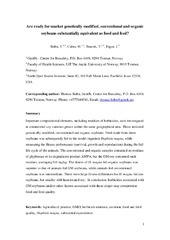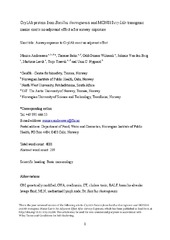Blar i forfatter "Bøhn, Thomas"
-
Are ready for Market Genetically Modified, Conventional and Organic Soybeans Substantially Equivalent as Food and Feed?
Bøhn, Thomas; Cuhra, Marek; Traavik, Terje; Fagan, John (Chapter; Bokkapittel, 2015)Important compositional elements, including residues of herbicides, were investigated in commercial soy varieties grown within the same geographical area. These included genetically modified, conventional and organic soybeans. Feed made from these soybeans was subsequently fed to the model organism Daphnia magna, while measuring the fitness performance (survival, growth and reproduction) during the ... -
Assessing the probability of detection of horizontal gene transfer events in bacterial populations
Townsend, Jeffrey P.; Bøhn, Thomas; Nielsen, Kaare Magne (Journal article; Tidsskriftartikkel; Peer reviewed, 2012)Experimental approaches to identify horizontal gene transfer (HGT) events of non-mobile DNA in bacteria have typically relied on detection of the initial transformants or their immediate offspring. However, rare HGT events occurring in large and structured populations are unlikely to be detected in a short time frame. Population genetic modeling of the growth dynamics of bacterial genotypes is ... -
Behaviour and habitat use of first-time migrant Arctic charr: novel insights from a subarctic marine area
Nordli, Eivind; Strøm, John Fredrik; Bøhn, Thomas; Thorstad, Eva Bonsak; Serra Llinares, Rosa Maria; Nilsen, Rune; Bjørn, Pål Arne (Journal article; Tidsskriftartikkel; Peer reviewed, 2023-04-13)Anadromous Arctic charr Salvelinus alpinus is a cold-adapted salmonid that is vulnerable to climate warming and anthropogenic activities including salmon farming, hydropower regulation, and pollution, which poses a multiple-stressor scenario that influences or threatens populations. We studied the horizontal and vertical behaviour of Arctic charr tagged with acoustic transmitters (n = 45, mean ... -
Behavioural responses of wild anadromous Arctic char experimentally infested in situ with salmon lice
Strøm, John Fredrik; Bjørn, Pål Arne; Bygdnes, Eirik Emil; Kristiansen, Lars; Skjold, Bjørnar; Bøhn, Thomas (Journal article; Tidsskriftartikkel; Peer reviewed, 2022-06-24)Salmon lice can impact the marine behaviour, growth, and survival of salmonids, but little is known about their effects on Arctic char. We present behavioural responses from the first dose-response experiment with wild anadromous Arctic char (n = 50) infested in situ with salmon lice (0.0–1.2 lice g<sup>−1</sup> fish) in an area with low natural infestations. Infested fish spent less time at sea ... -
Chronic Responses of Daphnia magna under Dietary Exposure to Leaves of a Transgenic (Event MON810) Bt-Maize Hybrid and its Conventional Near-Isoline
Holderbaum, Daniel Ferreira; Cuhra, Marek; Wickson, Fern; Orth, Afonso Inácio; Nodari, Rubens Onofre; Bøhn, Thomas (Journal article; Tidsskriftartikkel; Peer reviewed, 2015-08-11)Insect resistance is the second most common trait globally in cultivated genetically modified (GM) plants. Resistance is usually obtained by introducing into the plant’s genome genes from the bacterium Bacillus thuringiensis (Bt) coding for insecticidal proteins (Cry proteins or toxins) that target insect pests. The aim of this study was to examine the hypothesis that a chronic, high-dose dietary ... -
Clone- and age-dependent toxicity of a glyphosate commercial formulation and its active ingredient in Daphnia magna.
Cuhra, Marek; Traavik, Terje; Bøhn, Thomas (Journal article; Tidsskriftartikkel; Peer reviewed, 2013)Low levels of glyphosate based herbicide induced significant negative effects on the aquatic invertebrate Daphnia magna. Glyphosate herbicides such as brands of Roundup, are known to be toxic to daphnids. However, published findings on acute toxicity show significant discrepancies and variation across several orders of magnitude. To test the acute effects of both glyphosate and a commercial ... -
Co-existence challenges in small-scale farming when farmers share and save seeds
Bøhn, Thomas; Aheto, Denis; Mwangala, Felix; Bones, Inger Louise; Simoloka, Christopher; Mbeule, Ireen; Wikmark, Odd Gunnar; Schmidt, Gunther; Chapela, Ignacio (Chapter; Bokkapittel, 2013)Gene flow by means of pollen and seeds in maize influences local, regional and global maize biodiversity. Developing countries are centers of diversity for maize and preserve seeds also in informal seed systems. Particularly in poor communities, seed saving and sharing often co-occur with farming on small fields. We present preliminary investigations from a small-scale maize farming community, in ... -
The competitive edge of an invading specialist
Bøhn, Thomas; Amundsen, Per-Arne (Journal article; Tidsskriftartikkel; Peer reviewed, 2001-08-01)Introduced species represent major threats to native and natural biodiversity. On the other hand, biologists may increase the understanding of ecological interactions by following communities during establishment of exotic species. Accordingly, feeding ecology and habitat use were studied in native whitefish (<i>Coregonus lavaretus</i>) and recently invading vendace (<i>C. albula</i>) in two lake ... -
Competitive exclusion after invasion?
Bøhn, Thomas; Amundsen, Per-Arne; Sparrow, Ashley (Journal article; Tidsskriftartikkel; Peer reviewed, 2007-07-27)The ‘Competitive Exclusion Principle’ is a foundation stone in the understanding of interspecific competition and niche relationships between species. In spite of having the status of a biological law, the principle has limited empirical support. In this study, we document strong effects of competition from the invading fish species vendace <i>Coregonus albula</i> over a 14-year period in the ... -
Compositional differences in soybeans on the market: glyphosate accumulates in Roundup Ready GM soybeans
Bøhn, Thomas; Cuhra, Marek; Traavik, Terje; Sanden, Monica; Primicerio, Raul (Journal article; Tidsskriftartikkel; Peer reviewed, 2014)This article describes the nutrient and elemental composition, including residues of herbicides and pesticides, of 31 soybean batches from Iowa, USA. The soy samples were grouped into three different categories: (i) genetically modified, glyphosate-tolerant soy (GM-soy); (ii) unmodified soy cultivated using a conventional ‘‘chemical’’ cultivation regime; and (iii) unmodified soy cultivated using an ... -
Contrasting Population and Life History Responses of a Young Morph-Pair of European Whitefish to the Invasion of a Specialised Coregonid Competitor, Vendace
Sandlund, Odd Terje; Gjelland, Karl Øystein; Bøhn, Thomas; Knudsen, Rune; Amundsen, Per-Arne (Journal article; Tidsskriftartikkel; Peer reviewed, 2013)Invasions of non-native species represent a global problem of great scientific interest. Here we study in detail the response in population and life history characteristics of closely related native species, with divergent habitat preferences, that are impacted by an invading species over a sufficient time period to allow a new stable state to become established. A time series of 20 years starting ... -
Cry1Ab Protein from Bacillus thuringiensis and MON810 cry1Ab-transgenic Maize Exerts No Adjuvant Effect After Airway Exposure
Andreassen, Monica; Bøhn, Thomas; Wikmark, Odd Gunnar; van den Berg, Johnnie; Løvik, Martinus; Traavik, Terje; Nygaard, Unni Cecilie (Journal article; Tidsskriftartikkel; Peer reviewed, 2015-02-24)The genetically modified (GM) maize event MON810 has been inserted with a processed version of the transgene, cry1Ab, derived from the soil bacterium Bacillus thuringiensis (Bt) to express proteins with insecticidal properties. Such proteins may introduce new allergens and also act as adjuvants that promote allergic responses. While focus has been on safe consumption and hence the oral exposure to ... -
Demographic responses of Daphnia magna fed transgenic Bt-maize
Bøhn, Thomas; Traavik, Ingemar Terje; Primicerio, Raul (Journal article; Tidsskriftartikkel; Peer reviewed, 2009-10-27)The food/feed quality of a variety of genetically modified (GM) maize expressing Cry1Ab Bt-toxin was tested over the life-cycle of <i>Daphnia magna</i>, an arthropod commonly used as model organism in ecotoxicological studies. Demographic responses were compared between animals fed GM or unmodified (UM) near isogenic maize, with and without the addition of predator smell. Age-specific data on survival ... -
Detecting rare gene transfer events in bacterial populations
Nielsen, Kåre Magne; Bøhn, Thomas; Townsend, Jeffrey P. (Journal article; Tidsskriftartikkel; Peer reviewed, 2014) -
Detection of Transgenes in Local Maize Varieties of Small-Scale Farmers in Eastern Cape, South Africa
Iversen, Marianne; Grønsberg, Idun; van den Berg, Jonnie; Fischer, Klara; Aheto, Denis Worlanyo; Bøhn, Thomas (Journal article; Tidsskriftartikkel; Peer reviewed, 2014-12-31)Small-scale subsistence farmers in South Africa have been introduced to genetically modified (GM) crops for more than a decade. Little is known about i) the extent of transgene introgression into locally recycled seed, ii) what short and longterm ecological and socioeconomic impacts such mixing of seeds might have, iii) how the farmers perceive GM crops, and iv) to what degree approval conditions ... -
Ecological interactions and evolution: Forgotten parts of biodiversity?
Bøhn, Thomas; Amundsen, Per-Arne (Journal article; Tidsskriftartikkel; Peer reviewed, 2004-09-01)<p>Organisms are shaped contemporaneously by ecological processes and over long periods of time by evolution, processes that have led to the diversification of life. But is the diversity of life all biodiversity is? We argue that biodiversity is the conclusion drawn both from the variety of life forms and from the variety of processes that have shaped them. One cannot talk about biodiversity in a ... -
Effects of invading vendace (Coregonus albula) on species composition and body size in two zooplankton communities of the Pasvik River System, Northern Norway
Bøhn, Thomas; Amundsen, Per-Arne (Journal article; Tidsskriftartikkel; Peer reviewed, 1998-02-01)<p>Species composition and body-size distribution were studied in the crustacean zooplankton communities of two limnologically similar lake localities situated 50 km apart in the Pasvik River System, northern Norway. A recent invasion and successive downstream expansion of vendace (<i>Coregonus albula</i>), a specialized zooplanktivorous fish, allowed comparisons between sites with different predation ... -
Feeding ecology of piscivorous brown trout (Salmo trutta L.) in a subarctic watercourse
Jensen, Hallvard; Bøhn, Thomas; Amundsen, Per-Arne; Aspholm, Paul Erik (Journal article; Tidsskriftartikkel; Peer reviewed, 2004-02)Feeding ecology of piscivorous brown trout was studied in the Pasvik watercourse, Norway and Russia. The watercourse is heavily regulated for hydroelectric purposes, and 5000 brown trout > 25 cm are stocked annually to compensate the negative impacts of the impoundments. Stocked and wild trout had almost identical diets consisting mainly of vendace Coregonus albula and partly of whitefish Coregonus ... -
The German ban on GM maize MON810: scientifically justified or unjustified?
Bøhn, Thomas; Primicerio, Raul; Traavik, Terje (Journal article; Tidsskriftartikkel; Peer reviewed, 2012) -
Gill raker morphology and feeding ecology of two sympatric morphs of European whitefish (Coregonus lavaretus)
Amundsen, Per-Arne; Bøhn, Thomas; Vågå, G. H. (Journal article; Tidsskriftartikkel; Peer reviewed, 2004)Two whitefish morphs have been identified in lakes in northern Norway from a bimodal distribution of gill raker numbers: a sparsely- and a densely-rakered. Habitat choice and feeding ecology of whitefish were studied in five lakes with the two morphs living in sympatry, and in five lakes harbouring only the sparsely-rakered morph. In sympatry, the two whitefish morphs exhibited a strict niche ...


 English
English norsk
norsk


















